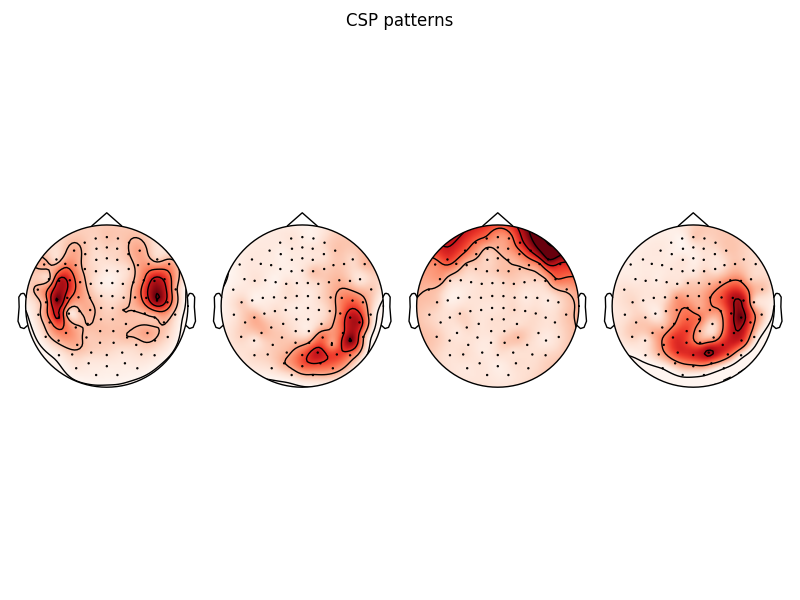Decoding applied to MEG data in sensor space decomposed using CSP. Here the classifier is applied to features extracted on CSP filtered signals.
See http://en.wikipedia.org/wiki/Common_spatial_pattern and [1].
| [1] | Zoltan J. Koles. The quantitative extraction and topographic mapping of the abnormal components in the clinical EEG. Electroencephalography and Clinical Neurophysiology, 79(6):440–447, December 1991. |
# Authors: Alexandre Gramfort <alexandre.gramfort@telecom-paristech.fr>
# Romain Trachel <romain.trachel@inria.fr>
#
# License: BSD (3-clause)
import numpy as np
import matplotlib.pyplot as plt
import mne
from mne import io
from mne.datasets import sample
print(__doc__)
data_path = sample.data_path()
Set parameters and read data
raw_fname = data_path + '/MEG/sample/sample_audvis_filt-0-40_raw.fif'
event_fname = data_path + '/MEG/sample/sample_audvis_filt-0-40_raw-eve.fif'
tmin, tmax = -0.2, 0.5
event_id = dict(aud_l=1, vis_l=3)
# Setup for reading the raw data
raw = io.read_raw_fif(raw_fname, preload=True)
raw.filter(2, None) # replace baselining with high-pass
events = mne.read_events(event_fname)
raw.info['bads'] = ['MEG 2443'] # set bad channels
picks = mne.pick_types(raw.info, meg='grad', eeg=False, stim=False, eog=False,
exclude='bads')
# Read epochs
epochs = mne.Epochs(raw, events, event_id, tmin, tmax, proj=True,
picks=picks, baseline=None, preload=True)
labels = epochs.events[:, -1]
evoked = epochs.average()
Out:
Opening raw data file /home/ubuntu/mne_data/MNE-sample-data/MEG/sample/sample_audvis_filt-0-40_raw.fif...
Read a total of 4 projection items:
PCA-v1 (1 x 102) idle
PCA-v2 (1 x 102) idle
PCA-v3 (1 x 102) idle
Average EEG reference (1 x 60) idle
Range : 6450 ... 48149 = 42.956 ... 320.665 secs
Ready.
Current compensation grade : 0
Reading 0 ... 41699 = 0.000 ... 277.709 secs...
Setting up high-pass filter at 2 Hz
l_trans_bandwidth chosen to be 2.0 Hz
Filter length of 496 samples (3.303 sec) selected
145 matching events found
4 projection items activated
Loading data for 145 events and 106 original time points ...
0 bad epochs dropped
Decoding in sensor space using a linear SVM
from sklearn.svm import SVC # noqa
from sklearn.cross_validation import ShuffleSplit # noqa
from mne.decoding import CSP # noqa
n_components = 3 # pick some components
svc = SVC(C=1, kernel='linear')
csp = CSP(n_components=n_components)
# Define a monte-carlo cross-validation generator (reduce variance):
cv = ShuffleSplit(len(labels), 10, test_size=0.2, random_state=42)
scores = []
epochs_data = epochs.get_data()
for train_idx, test_idx in cv:
y_train, y_test = labels[train_idx], labels[test_idx]
X_train = csp.fit_transform(epochs_data[train_idx], y_train)
X_test = csp.transform(epochs_data[test_idx])
# fit classifier
svc.fit(X_train, y_train)
scores.append(svc.score(X_test, y_test))
# Printing the results
class_balance = np.mean(labels == labels[0])
class_balance = max(class_balance, 1. - class_balance)
print("Classification accuracy: %f / Chance level: %f" % (np.mean(scores),
class_balance))
# Or use much more convenient scikit-learn cross_val_score function using
# a Pipeline
from sklearn.pipeline import Pipeline # noqa
from sklearn.cross_validation import cross_val_score # noqa
cv = ShuffleSplit(len(labels), 10, test_size=0.2, random_state=42)
clf = Pipeline([('CSP', csp), ('SVC', svc)])
scores = cross_val_score(clf, epochs_data, labels, cv=cv, n_jobs=1)
print(scores.mean()) # should match results above
# And using reuglarized csp with Ledoit-Wolf estimator
csp = CSP(n_components=n_components, reg='ledoit_wolf')
clf = Pipeline([('CSP', csp), ('SVC', svc)])
scores = cross_val_score(clf, epochs_data, labels, cv=cv, n_jobs=1)
print(scores.mean()) # should get better results than above
# plot CSP patterns estimated on full data for visualization
csp.fit_transform(epochs_data, labels)
data = csp.patterns_
fig, axes = plt.subplots(1, 4)
for idx in range(4):
mne.viz.plot_topomap(data[idx], evoked.info, axes=axes[idx], show=False)
fig.suptitle('CSP patterns')
fig.tight_layout()
fig.show()

Out:
Classification accuracy: 0.934483 / Chance level: 0.503448
0.934482758621
0.944827586207
Total running time of the script: ( 0 minutes 8.747 seconds)